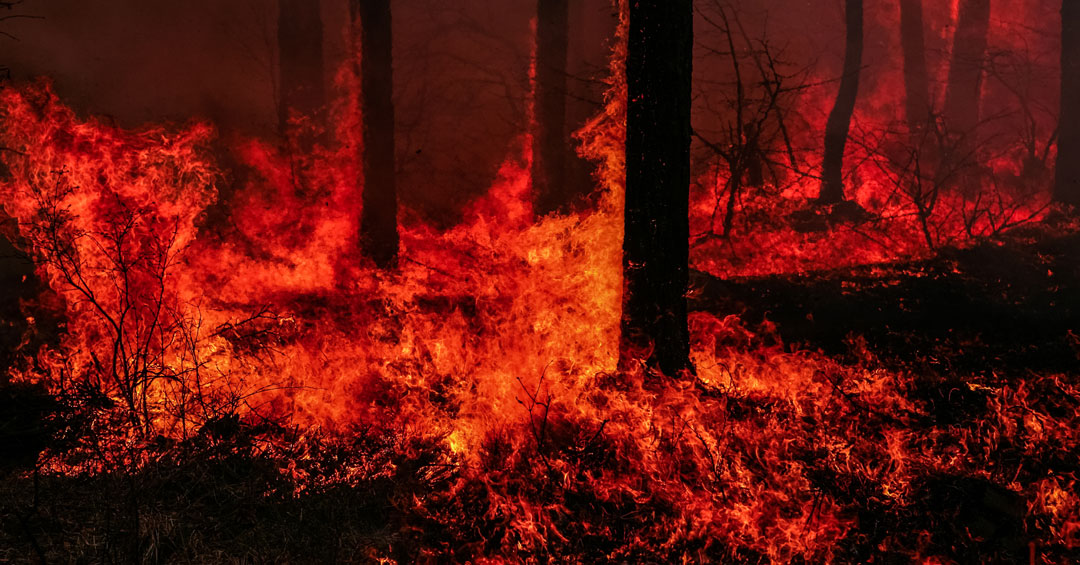Click here for information on storms, explosions, floods, droughts, sinkholes, and epidemics.
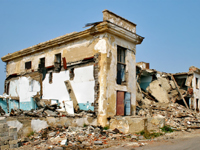 EARTHQUAKES
EARTHQUAKES
Virginia City, Nevada
Carson City and Lake Tahoe
Four significant earthquakes rumbled through Virginia City in the late 1860s— two in May of 1868, and two more in December of 1869.
The first pair occurred on Friday, May 29, 1868. The first shock occurred at around 9:20 p.m., the second about ten minutes later. Although it caused general consternation among the populace, there were no injuries and only minor structural damage, such as bricks shaken down and brick walls cracked.
The second pair occurred beginning Monday, December. 27, 1869 at about 6:00 p.m., with the second shock following about eight hours later, with numerous smaller aftershocks for a month afterward. There was substantial structural damage in Virginia City, with falling walls, landslides, and even shattering of the brick front to the Wells Fargo Express vault.
There was extensive disruption in the Comstock mines under the city as well, with reports that water rose in the mines from twenty to thirty feet. Trains over the Sierras were delayed while boulders were cleared from the tracks.
Additional but lesser earthquakes were reported during the 1880s, on June 3, 1887; June 30, 1888; November 15, 18, 24, 1894; January 27, 1896; May 15, 1897; and June 20, 1897.
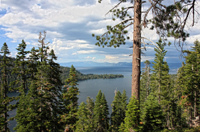
Lake Tahoe
Lake Tahoe, west of Virginia City, is cradled in a nest of earthquake faults; see Tsunamis, below.
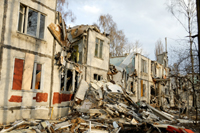 San Francisco
San Francisco
Relatively minor earthquakes have been reported with monotonous regularity in San Francisco since its earliest days. Some of the more notable major occurrences are given below.
July 21, 1864 – Several earthquakes rattled the City by the Bay, prompting Mark Twain (in the Call newspaper offices) to write, “…several persons started downstairs to see if there were anybody so timid to be frightened by a mere earthquake.”
October 8, 1865 – A severe earthquake damaged or destroyed several buildings, chimneys were shaken down, windows were broken and water and gas pipes ruptured. Near Howard Street a fissure nearly an inch wide opened for a length of two blocks.
May 29, 1868 – Two heavy earthquake shocks felt at 9:20 p.m. caused the audience at the Opera House to rush for the doors, fearing a boiler explosion. Newspaperman Alfred Doten reported that three female members of the audience, “…jumped from lower right hand stage box to the stage in a heap.” The quakes were felt throughout California and Nevada.
October 21, 1868 – A major earthquake struck the city just before 8:00 a.m., followed by a second shock an hour and a half later. Thirty people were killed, four people by falling masonry; buildings and chimneys were destroyed; portions of the landfill in the old Cove area subsided from six inches to many feet; fissures from two to six inches wide opened up in various parts of the city and water erupted from them.
April 1, 1872 – The San Francisco Real Estate Circular, in an attempt to reassure nervous Eastern investors, stated “San Francisco is in very little more danger of a disastrous earthquake than the Eastern States of being flooded by a overflow of the Atlantic ocean.”
No overflow of the Atlantic ocean has been reported to date, but has been overdue since 1906.
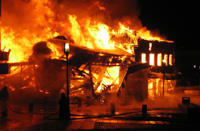 FIRES
FIRES
Fire was an ever-present danger in the mid-1800s, due to a lethal combination of flammable building materials, open-flame lighting, and heating from fireplaces and coal stoves.
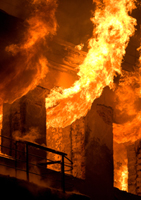 San Francisco
San Francisco
Six major fires marked the early days of San Francisco, burning over the central part of the city. They left behind piles of rubble that were scraped into the Bay, partially filling Yerba Buena Cove. Eventually the Cove was completely filled in, and today the central business district of the city is built on that land.
These fires occurred on:
December 24, 1849
May 4, 1850
June 14, 1850
September 17, 1850
December 14, 1850
May 4, 1851 (the “Great Fire”)
More damage was done by the final fire than had been done in all of the preceding ones.
On June 22, 1851, another fire started. This prompted changes in the building codes for the central district, mandating masonry buildings, double shutters and iron fire doors. Fires continued, but none of the destructiveness and extent of the earlier ones.
Until, of course, 1906.
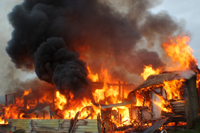 Virginia City
Virginia City
Fires of substantial magnitude occurred throughout Virginia City’s history, burning fiercely in the hot, dry Washoe air. Notable fires included:
2/1861 – Fire started in a cabin on A Street. Virginia City had no fire equipment, so citizens fought the fire by throwing snowballs at it.
8/29/1863 – Fire swept through Virginia City. A street fight broke out between two rival volunteer fire crews; the city burned while the fight raged on.
3/12/1869 – Fire in central section of Virginia City.
7/5/1870 – Major fire destroyed central section of Gold Hill, south of Virginia City.
10/25/1870 – Major fire destroyed 15-20 buildings in Virginia City.
2/1/1871 – Major fire destroyed central section of Virginia City.
8/20/1871 – Major fire destroyed central section of Virginia City.
9/20/1871 – Four entire city blocks burned. No fatalities were reported.
In 1875, fire struck repeatedly, on May 19, June 29, September 3, and October 6.
Then, on October 26, 1875, the Great Fire struck. It broke out in a boardinghouse on A Street and within hours had engulfed the city. By day’s end, 33 city blocks (over two-thirds of the city) had burned to the ground.
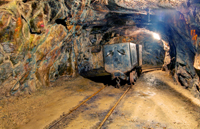 Mining Fires
Mining Fires
Catastrophic as the above-ground fires were, fires in the mines below the streets of Virginia City were even worse.
The mines consisted of countless miles of interconnected tunnels and shafts, all supported by flammable timbering. Once ignited, the passageways acted as chimneys and drew the fires ever deeper into the maze of tunnels. It was impossible to fight the fires effectively, and despite attempts to smother the flames with steam and earthen berms, the fires often burned for years.
Three primary mining fires occurred on the Comstock:
4/7/1869 – Major fire in the Yellow Jacket mine; explosion drove fire into the neighboring mines
9/20/1873 – Explosion and fire in Yellow Jacket mine.
10/30/1874 – Fire in the Belcher mine south of the Yellow Jacket and Crown Point mines in Gold Hill
destroyed the air shaft and released a column of flame 500 feet high.
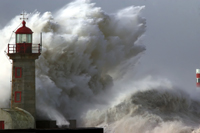 TSUNAMIS (“TIDAL WAVES”)
TSUNAMIS (“TIDAL WAVES”)
San Francisco
The October 21, 1868 earthquake in San Francisco spawned a tsunami approximately 14 feet (4.5 meters) high. This wave was apparently generated by a submarine landslide caused by the quake, and its effects were limited to unusual turbulence in the Bay and a high wave at the Cliff House.
Such waves could occur with future quakes as well. The USGS in December 2013 projected that if the epicenter of the March 11, 2011 quake off Japan had instead been in the Gulf of Alaska, a tsunami could have been generated capable of flooding San Francisco’s Financial District with seawater up to six feet deep and sending a 12-foot wall of water south to Pacifica and other coastal marinas.
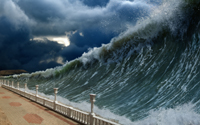 Lake Tahoe
Lake Tahoe
The Tahoe Basin is bounded by faults on the northern and western sides; the northern section appears to be the most tectonically active. The last major earthquake in this system was about 4,000 years ago; it shifted the ground beneath Lake Tahoe 12 to 20 feet vertically, spawning a giant tsunami.
Geologists warn that the faults beneath Lake Tahoe are capable of generating a 7.1-magnitude quake, enough movement to produce tsunami waves exceeding 30 feet in height. An earthquake-generated landslide along the steep fault-formed range-front on the west edge of Lake Tahoe could also generate a major tsunami in the lake.
FURTHER READING AND OTHER REFERENCES
Earthquakes
Virtual Museum of the City of San Francisco, San Francisco Earthquake History 1769-1879, www.sfmuseum.net/alm/quakes1.html
California Department of Conservation, Earthquake history, San Francisco http://www.conservation.ca.gov/cgs/geologic_hazards/earthquakes/Pages/index.aspx#HistoricQuakes
Fires
Frady, Steve. Red Shirts and Leather Helmets: Volunteer Fire Fighting on the Comstock Lode. Univ of Nevada Press, November 1984.
Guardians of the City website, containing historical information on the fire, police, sheriff, and paramedic departments of San Francisco, http://www.guardiansofthecity.org/index.html.
Tsunamis
Live Science, “Tsunamis, Earthquakes Overdue in Lake Tahoe”, December 06, 2012 http://www.livescience.com/25287-lake-tahoe-tsunami-earthquake-risk.html
California Department of Conservation, Tsunami maps, San Francisco http://www.conservation.ca.gov/cgs/geologic_hazards/Tsunami/Inundation_Maps/SanFrancisco/Pages/SanFrancisco.aspx
(Posted February 2014)
